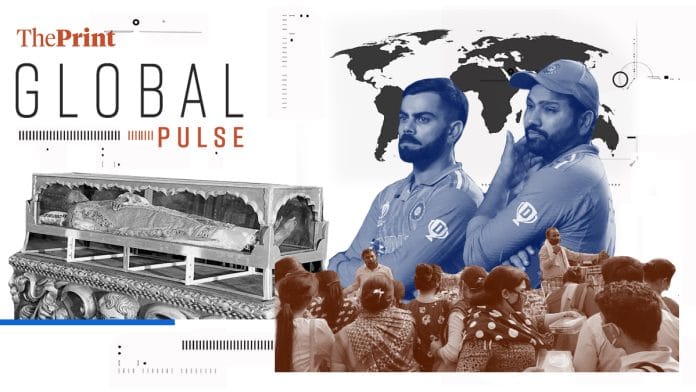New Delhi: The rich are spending more and the middle class is spending less in India, according to Bloomberg.
There is a “bipolarity” in the Indian economy—both the premium urban economy and the rural economy are faring well, but the middle class is sandwiched in between, writes Bloomberg.
“Mid-sized towns are seeing a slowdown, mid-sized packets of goods are not selling well, and mid-range consumer goods are also not growing,” the story says. What seems to be selling are luxury apartments, jewellery, and expensive weddings. The middle-class, on the other hand, are cutting back on basic consumables like soaps, biscuits, and cooking oil.”
It’s a strange contradiction when companies like Kalyan Jewellers and SUV sellers Mahindra & Mahindra see revenue growth while companies that cater to the masses don’t. But it reflects the economic pressures on India, Bloomberg says, slowing wage growth and elevated inflation have resulted in financial stress. Like ThePrint’s recent column suggested, perhaps the understanding of middle income needs to be expanded—earning Rs 1 crore isn’t cutting it anymore.
Things are looking bad for consumers. But all is not yet lost for the companies, Bloomberg reports.
“Weighed down by moderating consumption—as well as hit by the higher raw-material costs of goods from palm oil to wheat—firms are adopting a range of strategies to seek out growth,” writes Bloomberg. “Firms across sectors, from personal care to food to bicycles, are pushing their premium products in a rush to appeal to wealthier buyers.”
But this strategy could backfire if the slowdown persists, the report says.
The BBC reports on the “fall” of India’s cricket supremacy—from glory to gloom, the piece says, almost ruefully.
India’s recent form has been very troubling, and the BBC doesn’t spare any punches towards a team that’s still reeling from a humiliating 1-3 defeat in the test series against Australia.
“The defeats have raised questions about the team’s depth, the future of key players like captain Rohit Sharma and former skipper Virat Kohli, and their ability to rebuild. With a team in transition and stalwarts fading, Indian Test cricket faces pressing challenges to sustain its legacy in a rapidly evolving landscape,” the story says.
Sharma struggles to find his batting position despite once being a “blazing match-winner,” the story says, while Kohli’s “surreal decline—after a decade of dominance and swagger—has left cricket’s former titan in an extended slump.”
The issue now is finding a successor to Kohli. The baton of batting passed from Sunil Gavaskar to Sachin Tendulkar to Kohli, but now the options are limited.
“K.L. Rahul has the class but lacks the hunger for consistent big scores. Rishabh Pant is a thrilling maverick, equally capable of winning or losing a match. Shubman Gill, touted as the next Big Thing, has struggled overseas despite his undeniable pedigree and needs careful nurturing,” the story says.
India’s talent pool is “brimming”, however, especially with Jasprit Bumrah, Mohammed Shami and Mohammed Siraj. But Bumrah is a once-in-a-generation talent, and shouldn’t be overburdened, the story says.
“Managing a team in transition poses complex challenges requiring patience, empathy, and clear vision. Knee-jerk reactions or external pressure could worsen the situation instead of providing solutions,” writes the BBC. “Whether Sharma and Kohli can overcome their crisis remains to be seen, but India’s wealth of talent should lift the current gloom surrounding Indian cricket.”
The Economist travels to Goa to attend one of the state’s most interesting traditions: the once-a-decade exposition of St. Francis Xavier, whose corpse is 472 years old.
The 18th exposition since 1752 ended on 5 January, and nearly 8 million pilgrims visited to bow, pray, and take the blessings of St Francis Xavier. “Christians, Hindus, Muslims and others asked for the saint’s grace,” the story says.
The body of St Francis Xavier, who spent over a decade evangelising in India, Malacca and Japan, was brought to Goa miraculously preserved in 1544, and canonised in 1622. Today, he is the patron saint of Goa, with his feast day, 3 December, a public holiday.
“The most recent census, in 2011, found that 2.3 percent of Indians are Christians—roughly 32m people today, or half an Italy. Yet they have been increasingly targeted by Hindu-nationalist groups, sometimes violently,” the story says.
It goes on to describe how last year, a local Hindu group claimed that a church had been built on the site of a razed temple, while another Hindu leader demanded a DNA test of St Francis Xavier.
“Right-wingers portray him as a tormentor of Hindus for his role in the Goa inquisition,” The Economist writes. “It is undeniable that the inquisition was particularly bloody. But if ‘for 450 years nothing happened, why now?’ asks Mario Monteiro, who has attended every exposition since 1984. Today Francis Xavier is a symbol of Goa’s—and India’s—syncretism. That is the true target of the new holy warriors.”
Also read: India, Taliban meet sure to ruffle Pakistan’s feathers & Ketan Parekh and the ‘front-running bug’






